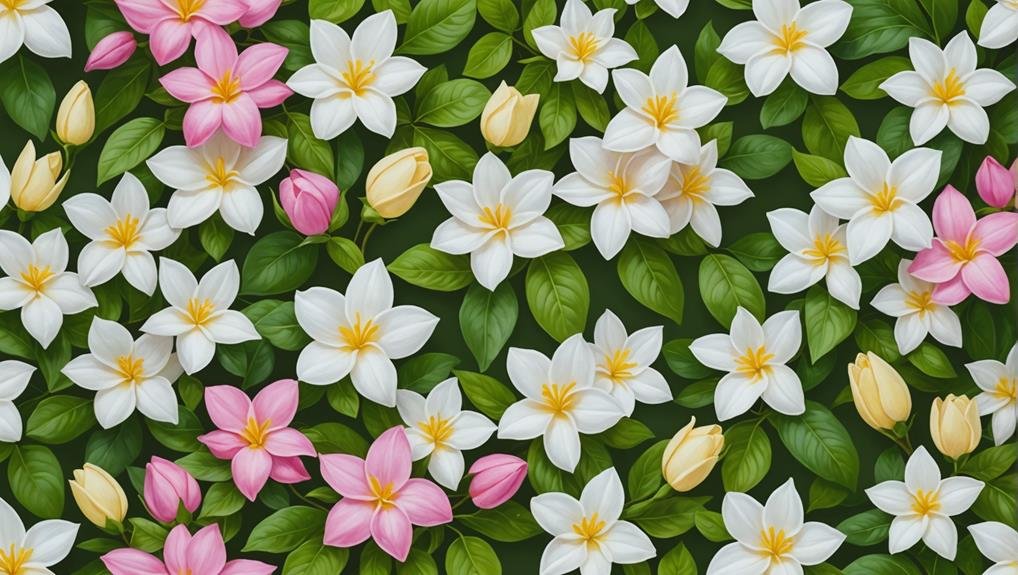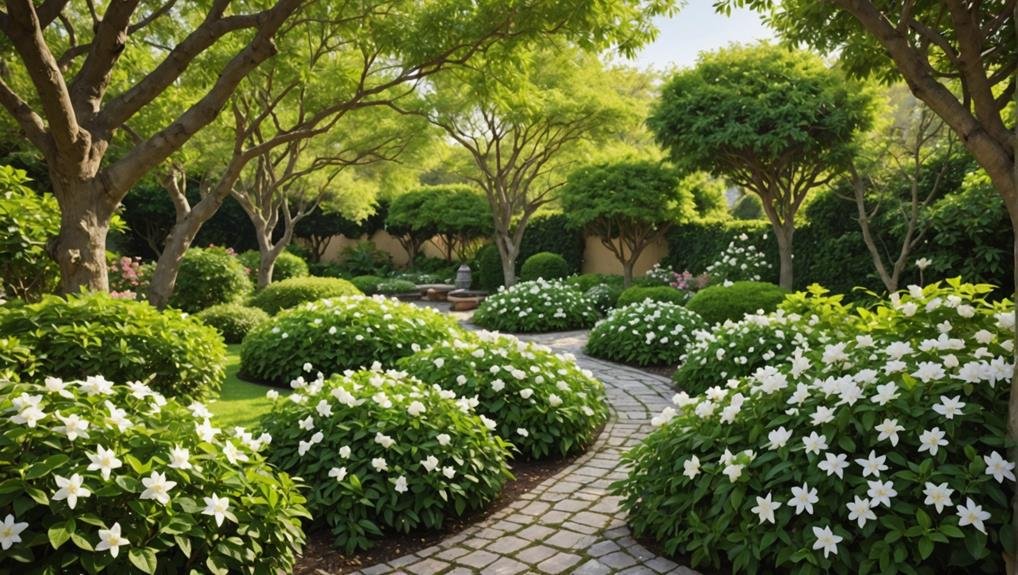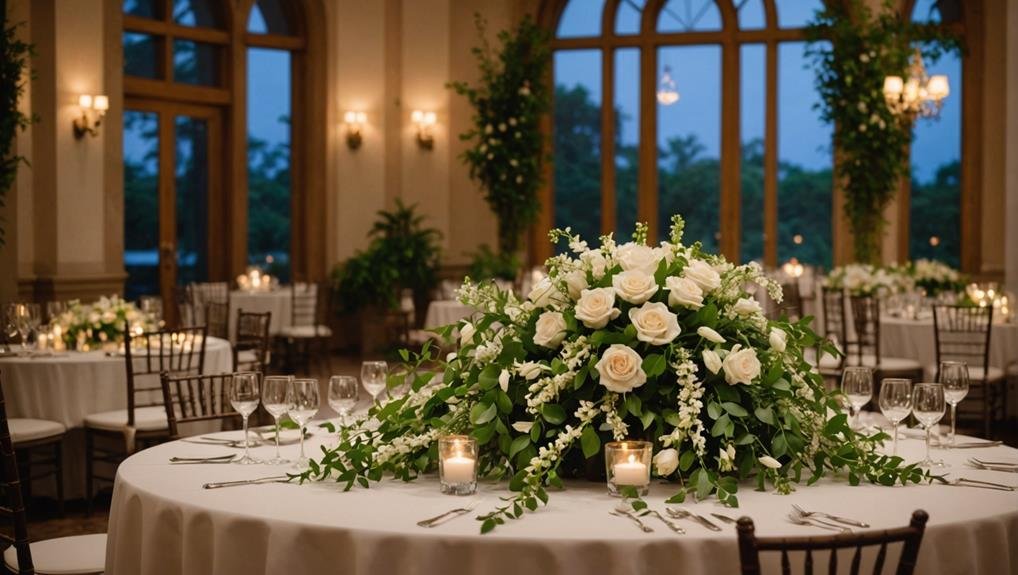Jasmine, with its delicate star-shaped blooms and enchanting fragrance, holds a special place in wedding ceremonies across various cultures. Originating from South and South East Asia, this flower symbolizes love, purity, and beauty, making it a preferred choice for bridal bouquets and floral arrangements. With over 200 species ranging from pristine white to soft pink hues, jasmine's elegance is unmatched. Its year-round availability and versatile use further enhance its appeal. But what truly sets jasmine apart in wedding floristry? Let's explore its multifaceted charm and why it remains an enduring favorite among couples.
Flower Overview

Jasmine, encompassing over 200 species of shrubs and vines native to South and South East Asia, is renowned for its delicate, highly scented star-shaped blooms. This versatile plant, often found in pristine white and occasionally in soft pink, is a cherished addition to various floral arrangements, particularly in bridal bouquets. Its enchanting fragrance and elegant appearance make it a popular choice among brides looking to infuse their wedding day with a touch of timeless beauty and aromatic allure.
Incorporating jasmine into a bridal bouquet not only enhances the visual appeal but also imbues the arrangement with a memorable scent that can evoke lasting memories of the special day. The plant's flexibility allows it to be used in both cut flower form and as a live plant, offering multiple avenues for creative floral designs.
For those opting to purchase jasmine as a cut flower, proper care is essential to maintain its freshness and fragrance. Misting the leaves and flowers, avoiding draughty areas, and strategic placement within the bouquet can guarantee that jasmine remains a stunning focal point throughout the wedding celebration.
Physical Description
Beyond its enchanting fragrance and versatility in floral arrangements, the physical characteristics of jasmine make it a standout choice for wedding bouquets. The star-shaped white flowers of the jasmine plant, often referred to as Madagascar jasmine, are set against glossy, vibrant green leaves, creating a striking contrast that enhances any floral display. These blossoms are hardy in USDA zones 10 and 11, making them suitable for various climates and growing conditions.
Bridal jasmine is known for blooming on new wood, which necessitates pruning post-flowering to maintain its health and vigor. Optimal growth is achieved in rich, well-drained soil and with exposure to morning sun, underscoring the plant's preference for specific growing conditions. Interestingly, the seed pods of bridal jasmine take approximately a year to ripen, with seeds becoming viable only after the pods crack open.
| Feature | Description | Notes |
|---|---|---|
| Flower Shape | Star-shaped | Enhances visual appeal |
| Flower Color | White flowers | Symbolizes purity and elegance |
| Leaf Texture | Glossy | Provides a striking contrast |
| Hardiness Zone | USDA zones 10 and 11 | Suitable for warm climates |
| Blooming Condition | New wood | Requires post-flowering pruning |
This combination of aesthetic and practical attributes solidifies jasmine's position as a favored choice for weddings.
Available Colour Varieties

While commonly celebrated for its pristine white blooms, jasmine also occasionally graces floral arrangements with delicate pink flowers.
The prevailing color variety of jasmine is white, which symbolizes purity and love, making it an ideal choice for weddings. The delicate white blossoms of jasmine add an unmistakable touch of elegance and romance to any floral arrangement, enhancing the overall aesthetic appeal of the event.
The versatility of white jasmine flowers allows them to seamlessly complement a wide range of color palettes and wedding themes. Whether incorporated into a classic, vintage, or modern wedding, white jasmine effortlessly blends with other floral elements, providing a cohesive and harmonious look. Its timeless beauty and sweet fragrance further enhance its appeal, making it a favored option for bridal bouquets and wedding decor.
Occasionally, pink jasmine flowers are available, offering an alternative for those seeking a subtle variation in their floral design. However, the white jasmine remains the most popular and widely available choice due to its symbolic meaning and aesthetic charm.
Latin Name and Taxonomy
How does one classify the elegant and aromatic jasmine within the botanical hierarchy? Jasmine is scientifically recognized by its Latin name, Jasminum. This genus falls under the family Oleaceae, which includes other notable plants such as olives and lilacs. The Jasminum genus comprises more than 200 species, each exhibiting unique characteristics regarding flower color, scent intensity, and growth habits.
Some of the most commonly known species include Jasminum officinale, Jasminum sambac, and Jasminum polyanthum. Jasminum officinale, often referred to as common jasmine or poet's jasmine, is renowned for its strong fragrance and white flowers. Jasminum sambac, also known as Arabian jasmine, is highly valued in perfumery and traditional medicine for its potent aroma. Jasminum polyanthum, or pink jasmine, is admired for its prolific blooming and pinkish-white flowers.
To better understand the taxonomy of jasmine, the table below provides a visual representation:
| Feature | Description | Examples |
|---|---|---|
| Family | Oleaceae | Olive, Lilac |
| Genus | Jasminum | Jasmine |
| Common Species | Jasminum officinale | Common Jasmine |
| Jasminum sambac | Arabian Jasmine | |
| Jasminum polyanthum | Pink Jasmine |
Understanding the botanical classification of jasmine aids in appreciating its diverse applications and cultural significance.
Geographical Origins

Understanding the taxonomy of jasmine sets the stage for exploring its geographical origins, which trace back to South and South East Asia. This region is home to the majority of the over 200 species of jasmine, ranging from delicate shrubs to hardy vines. The natural habitat, characterized by warm, tropical climates, provides the ideal conditions for jasmine to thrive.
The plant's pointed green leaves and highly scented star-shaped blooms, mostly white but occasionally pink, are signature features that have captivated admirers worldwide.
Interestingly, not all jasmines hail from Asia. Madagascar Jasmine, also known as Stephanotis, is native to Madagascar, showcasing the adaptability and diversity of this floral genus. Despite its name, Madagascar Jasmine is not a true jasmine but shares similar aesthetic qualities, such as its alluring fragrance and exquisite white blossoms.
This particular variety underscores the geographical spread and cultural significance of jasmine-like plants beyond their Asian roots.
Season Availability
Jasmine flowers boast year-round availability, making them an excellent choice for wedding arrangements in any season. This perennial accessibility is largely due to the hardy nature of jasmine plants, which can thrive in various climates and conditions. While seasonal availability may vary based on specific jasmine varieties and local climate conditions, the overall versatility of jasmine affirms that it remains a reliable option for florists and brides alike throughout the year.
Different jasmine varieties have peak blooming seasons, with some flowering in spring and others in summer. This diversity in blooming times further enhances their year-round presence. For instance, common jasmine (Jasminum officinale) typically blooms in late spring to summer, while winter jasmine (Jasminum nudiflorum) can bloom as early as late winter. These variations provide unique opportunities for incorporating jasmine into wedding floral designs regardless of the month.
Additionally, jasmine can be grown indoors, allowing for the enjoyment of its fragrant blooms even outside its natural outdoor blooming season. This indoor cultivation capability further solidifies jasmine's status as a versatile and dependable flower choice. Therefore, couples planning their nuptials can confidently include jasmine in their wedding floral arrangements, knowing it will be available year-round.
Growing Conditions

Growing bridal jasmine successfully necessitates specific conditions regarding climate, soil, and sunlight. This delicate yet resilient plant thrives in USDA zones 10 and 11, making it ideally suited for warm climates such as Hawaii and parts of California.
For best growth, bridal jasmine requires fertile, well-drained soil. Ensuring that the roots are kept cool while the foliage enjoys ample sunlight is essential. Although morning sun exposure is recommended, bridal jasmine can also tolerate full sun conditions, provided that the soil retains adequate moisture and nutrients.
Temperature plays a pivotal role in the health of bridal jasmine. During winter, it is beneficial to allow the plant to rest in cooler conditions, ideally between 55-65 degrees Fahrenheit. This dormancy period helps the plant to conserve energy and prepare for vigorous growth in the following season.
Additionally, regular pruning after the flowering period in autumn or winter is necessary. Pruning not only helps maintain the plant's shape but also encourages new growth, ensuring a lush and vibrant appearance.
Cultural Significance
The cultural significance of jasmine in wedding ceremonies spans across various traditions and regions, symbolizing love, purity, and beauty. In Hindu weddings, jasmine garlands are exchanged between the bride and groom as a profound gesture of love and commitment. These garlands, often intricately woven, play a central role in the ceremonial proceedings, underscoring the sanctity of the marital bond.
In traditional Chinese weddings, jasmine holds a special place as well. The flowers are used to represent good luck and blessings for the couple's new life together. The delicate white blooms not only enhance the aesthetic appeal of the occasion but also imbue it with a sense of grace and elegance that transcends cultural boundaries.
The fragrance of jasmine is another aspect that contributes to its cultural significance. Believed to bring positivity and joy, the sweet scent of jasmine flowers creates an uplifting atmosphere, fostering a sense of harmony and celebration.
Across various cultures, the presence of jasmine in wedding ceremonies is more than just decorative; it is a symbol of the beauty, purity, and enduring love that marriage represents. This rich cultural heritage makes jasmine an enduring favorite in wedding floral arrangements worldwide.
Typical Use in Weddings

Incorporating jasmine into wedding decor offers a timeless blend of elegance and aromatic charm, making it a versatile choice for various elements of the celebration. Jasmine is a popular selection for bridal bouquets due to its symbolic representation of love, purity, and elegance. The delicate white blossoms provide a classic and refined touch, perfectly complementing the bride's attire.
Moreover, the sweet fragrance of jasmine adds a romantic and sensory element to the ceremony, enhancing the overall ambiance.
Jasmine is not limited to bridal bouquets; it is widely used in garlands and other floral arrangements. Its versatile nature allows it to be seamlessly integrated into wedding arches, creating a picturesque backdrop for vows. Centerpieces adorned with jasmine can elevate the aesthetic of reception tables, offering a cohesive floral theme throughout the event.
Additionally, incorporating jasmine into cocktails and even wedding cakes can provide a unique and memorable touch, ensuring the floral motif is consistently present. The aromatic presence of jasmine guarantees that it leaves a lasting impression on guests, making it an excellent choice for those seeking to create an enchanting and memorable wedding celebration.
Alternative Flower Types
When considering alternatives to jasmine for wedding flowers, stephanotis stands out for its fragrant white blossoms and elegant appearance. Known for its striking tubular flowers set against waxy green leaves, stephanotis is an excellent option for bridal arrangements. This medium-sized vine, originating from Madagascar, belongs to the Apocynaceae family and typically reaches a mature size of up to 10 feet when supported by a trellis. It thrives in full sun or bright shade, making it a versatile choice for various wedding settings.
Stephanotis, often referred to as Madagascar jasmine, is hardy in USDA zones 10 and 11. However, it can also be grown indoors in other regions, allowing for year-round availability. The vine's fragrant blooms make it a popular choice for bridal bouquets, corsages, and other wedding floral arrangements, offering a classic and timeless appeal.
For those interested in growing stephanotis, or bridal jasmine, the process involves soaking seeds in warm water, sowing them in a damp seed-starting mix, and maintaining a temperature of around 75 degrees Fahrenheit for best sprouting. This makes stephanotis not only a beautiful but also a manageable alternative for wedding décor, ensuring stunning and fragrant displays.
